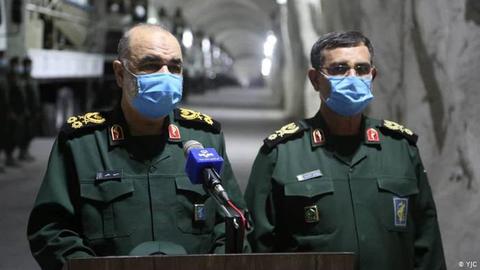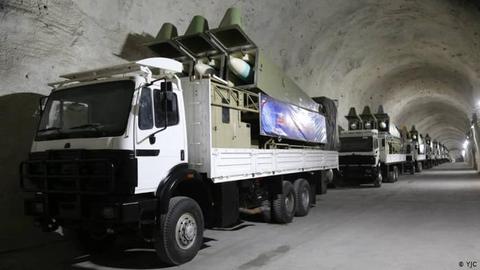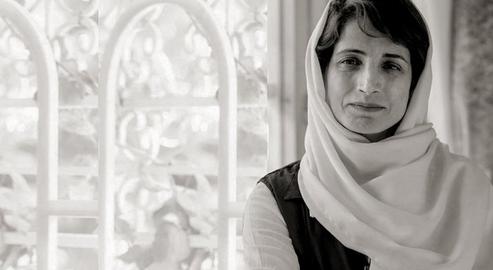In the midst of any political or security crisis, the Islamic Revolutionary Guards Corps (IRGC) resorts to one of its favorite public relations tactics: amplifying its "unparalleled military might”, usually through an elaborate display of its weaponry. It did so again on Monday, March 15, unveiling what it has dubbed a "new missile city”. The move is likely a follow-through response linked to Tehran’s insistence that Israel was behind the attack on an Iranian container ship in the Mediterranean on March 12 and adds to the overall tension between the United States and the Islamic Republic.
So how many of these missile cities have the Revolutionary Guards designed and presented to the world? What details are available about them? What's the history behind these elaborate stunts and do they work?
The New "Missile City"
News about the missile city was broadcast on Islamic Republic of Iran television, along with a four-and-a-half-minute video. Alongside comments from Revolutionary Guards Commander-in-Chief Hossein Salami and naval Commander Alireza Tangsiri, there were images of underground tunnels and other outdoor sections of the site.
The video’s narrator announced that a two-part ceremony was held on Monday, March 15. First there was the ”Unveiling of the IRGC Navy's new missile base and city,” which was followed by an event that went into more detail, outlining what was described as "a large amount of electronic warfare equipment” linked to the IRGC Naval Combat Unit.
The video shows areas of the “city” with displays of memorial photographs of Quds Force Commander Ghasem Soleimani and Popular Mobilization Front Commander Abu Mahdi al-Muhandis, who were killed by the United States military in January 2020, and of nuclear scientist Mohsen Fakhrizadeh, who was killed in November 2020.
Immediately following the release of the video, analysts and websites that monitor military activity rushed to comment. Intelligence consultancy Intel Lab posted an image of one outside location featured in the IRGC footage on Twitter, identifying it as "a military base near Shiraz." The Intel Lab also commented on the tunnels, stating that there were speculations about their exact location and that they “should be close to the seashore,” but that nothing could be proven at the moment.
Israeli newspaper The Jerusalem Post estimated that about 170 Nasr anti-ship missiles could be seen in the video.
This is not the first time that details about the Islamic Republic’s propaganda frenzy or about claims made by the Revolutionary Guards and its military or nuclear capabilities have been unveiled to the public. In some cases, these revelations have even led to the disclosure of sensitive information.
In April 2020, VOA revealed that Iranian state television had shown footage of a secret missile site in Semnan. In May 2018, The New York Times reported that US researchers had discovered a missile facility 35 kilometers southeast of the city of Shahroud after examining footage shown on Islamic Republic of Iran Broadcasting (IRIB) television as part of a memorial program marking the life of Hassan Tehrani Moghaddam, the scientist who ran the site and died during an explosion there. The IRIB program showed a quick glimpse of Tehrani Moghaddam in the facility’s operations room in front of a board bearing the word “Sharoud”.
One of the worst fallouts from such video releases, at least regarding Iran’s nuclear program, was former president Mahmoud Ahmadinejad’s 2009 filmed visit to the Natanz nuclear facility in 2009. The film zoomed in on the screens of the facility and displayed information that was said to have helped build the Stuxnet computer virus. That mistake sent shockwaves throughout Iran and the world.
How Many "Missile Cities" Are There?
Revolutionary Guards commanders have made various comments about so-called missile cities over the years. One example is Alireza Tangsiri, the commander of the IRGC Navy, who said in July 2020: "We have missile launcher cities and we will display them whenever appropriate."
Five years ago, Hassan Karimpour, an adviser to Ghasem Soleimani, announced that the Islamic Republic had "14 underground depots of missiles at a depth of between 30 and 500 meters."
The Revolutionary Guards have promoted this particular “new” missile city five times so far. In addition to the latest claims on March 15, officials also made the following mentions:
- In October 2015, images of an underground tunnel were broadcast on IRIB TV, along with the announcement that this was the first time that the images were allowed to be shown.
- Three months later, on January 5, 2016, state TV ran photographs of Ali Larijani, who was then Speaker of the Islamic Consultative Assembly, at what it described as a ceremony for the "Unveiling of a Missile City at a Depth of 500 Meters.”
On February 7, 2019, a video entitled "Iran's missile city in the depths of the earth,” which the Revolutionary Guards referred to as an underground ballistic missile factory, was released. Hassan Rouhani later commented: "The underground cities were shown to disrupt the JCPOA (the Joint Comprehensive Plan of Action); they wrote slogans on the rocket to disrupt the JCPOA."
- In mid-January 2020, after the Revolutionary Guards launched a missile attack on the Ain al-Assad base in Iraq in retaliation for the assassination of Ghasem Soleimani, images of a "missile city" were made public, with the Guards identifying it as a solid fuel missile depot.
But it is not clear whether the images shown were of five different points or “cities”; some of the images were similar. Secondly, in all the five above instances, news of the missile city was announced in the midst of a political-military crisis, such as the JCPOA, the assassination of Ghasem Soleimani, and explosions in Khojir and Natanz. In such circumstances, talking about military might was designed as a blow to the United States and Israel on the one hand, and a rejuvenation for the supporters of the Islamic Republic on the other.
The Politics Prompting the Unveiling of the City
Reports of the Guards’ new missile city surfaced as tensions continued between the US and and Iran, amid speculation about whether the Biden administration would be rejoining the nuclear deal, the JCPOA intensified. President Hassan Rouhani and his cabinet have not commented on the matter recently.
Such potential developments may have also prompted activity by Iranian-supported militias, including a Houthi attack in the Taiz region of Yemen that killed three children on March 14 and an attack on an Iraqi base where US soldiers were stationed that was thought to be linked to Iran. Iran described the attack on Iranian ship Shahrekord in the Mediterranean as an act of terror, and its accusation that Israel was responsible has contributed to the ongoing hostilities between the two countries. Iranian Foreign Ministry spokesman Saeed Khatibzadeh said the location where the attack took place — the ship's captain told Tasnim News Agency it was about 75 miles off the coast of Israel — made it clear that Israel was responsible.
That attack followed an Israeli ship being damaged by explosives in the Gulf of Oman in late February.
According to The Wall Street Journal, Israel has attacked at least 12 Iranian sea vessels on their way to Syria over the last 15 months.
visit the accountability section
In this section of Iran Wire, you can contact the officials and launch your campaign for various problems



























comments